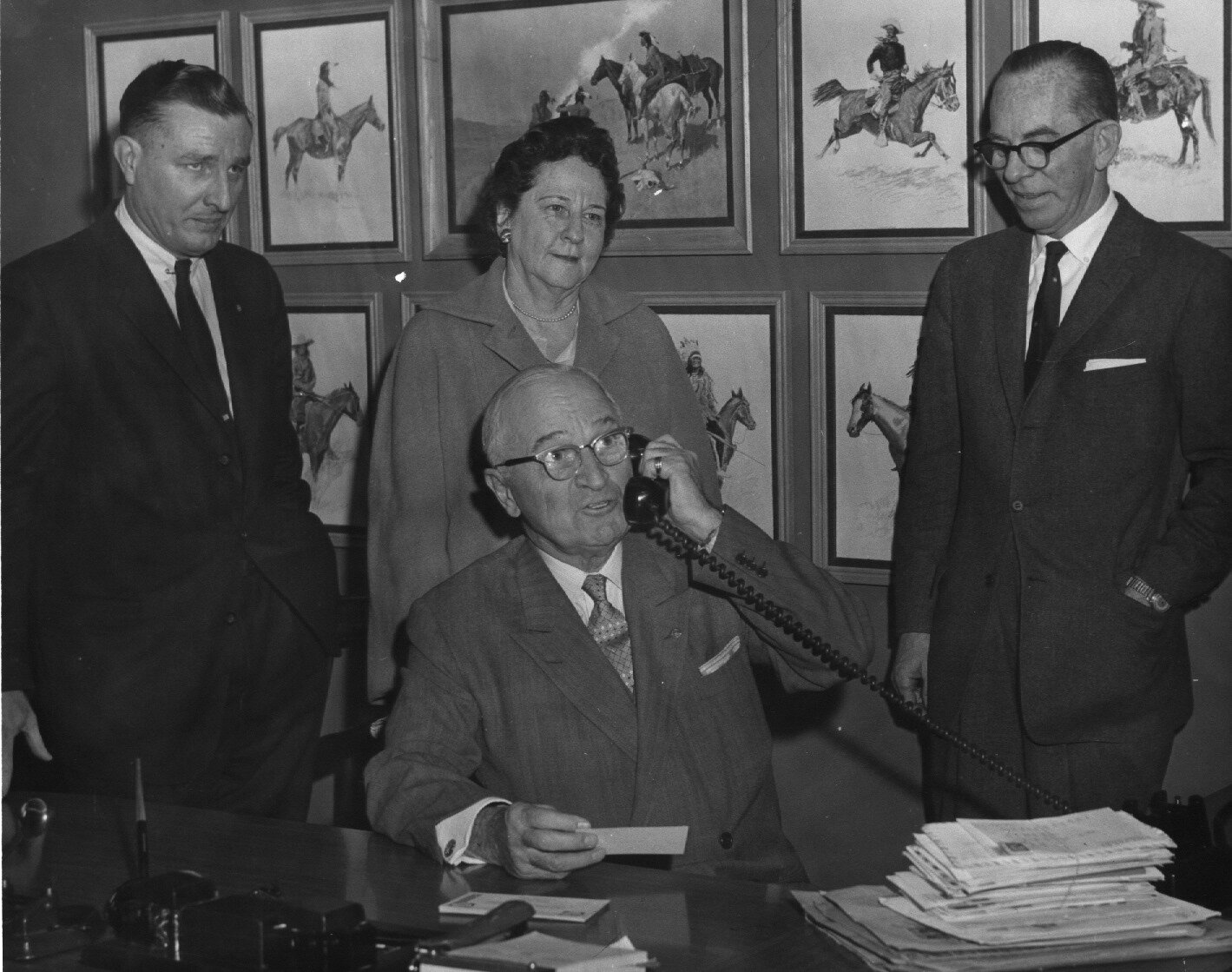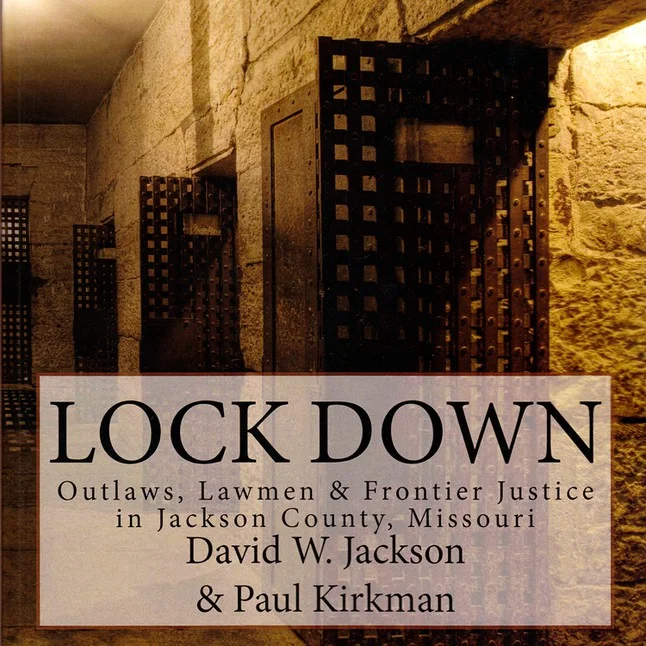President Harry S. Truman makes the first phone call to secure the first $1,000 donation for the 1958 restoration from Joyce C. Hall of Hallmark Cards, Inc.
A Jail, a Home, a Legacy
In 1958, a used building materials dealer nearly got permission to demolish the brick home, limestone jail, and brick cell block addition. The dealer would get the right to claim the salvaged stone, brick, and timber as the price for his work.
The abandoned buildings were given a new lease on life when a group of civic-minded citizens at the Jackson County Historical Society stepped in. They realized that there was yet another historical role for the two-story house and the jail hidden from street view at the corner of Main Street and what is now Truman Road.
Sketch of the 1859 Jail and residence around the time of completion.
Frontier Construction
The jail was constructed in 1859 using a design by Asa Beebe Cross, a notable early architect in Kansas City, Missouri. The third Jackson County jail constructed, consisted of a home for the jailer, an office for the county marshal and his staff, with twelve limestone jail cells. A brick structure was added to the rear of the original jail in 1907 to house chain gangs who worked on roads, sewers and other public projects.
Jackson County built the jail and home for $11,844.20 in 1859--the 2013 equivalent of $325,893.07.
Details about the current condition of the 1859 Jail Museum are included in a 2019 Historic Building Assessment and Structural Study done by Strata Architecture and Preservation.
The 1859 Jail and the residence are listed as “County Jail” at 217 N. Main Street on this 1916 Sanborn Fire Insurance Map from Independence, Jackson County, Missouri. Courtesy of the Library of Congress.
Life living in front of a Cell Block
The jailer or deputy county marshal lived with his family in the brick home at the front of the property. The wife of the jailer often cooked meals for the prisoners, as well as her own family, in a small kitchen at the back of the house. Some of the wives had assistance from house maids and cooks in taking care of the prisoners. The jailer in 1884 was paid about $50 per month, plus the use of the house, for his services. The marshal's office formed part of the residence. The marshal was a county elected position. He would appoint his deputies and jailers for two year terms. If reelected, they would stay on for multiple terms. The office had a separate entryway from the house to allow bookings and legal affairs to take place separate of the family living in the home.
The Cell Block
The 1859 portion of the jail consisted of six upstairs and six downstairs cells, with two-foot thick walls of limestone blocks. A single kerosene lamp in the hallway provided the only light at night. Two doors, one of grated iron and one of solid iron, were provided for each cell. A window covered with grated iron permitted wind and natural light from the outside to enter the cell. The cells were not heated or cooled. Some prisoners incarcerated inside died of exposure during the jail's history. Each cell was six by nine feet and designed to hold three prisoners, though, during the Civil War, as many as twenty prisoners were confined in each one.
In 1907, a brick jail addition was connected to the limestone structure to add more space for more prisoners. These prisoners formed chain gains to complete public works projects throughout Jackson County.
Some of the crimes a person imprisoned in the jail before the Civil War included: horse racing on public streets, firing guns in town, operating a gaming house, assault and battery, disturbing the peace, disturbing a religious meeting, or building a privy "not over a pit." Most prisoners following the Civil War were held for murder, theft, assault, and kidnapping.
Stories from the Cells
During the American Civil War, the jail held both military and civilian prisoners and served as the U.S. Provost Marshal's office. William Clark Quantrill, the famous Confederate guerrilla leader, was briefly incarcerated there. Quantrill met an angry mob upon his release from the facility. William Howard, the founder of Lee's Summit, and a Southern sympathizer, was an example of individuals who refused to take a pro-Union loyalty oath who was incarcerated during the Civil War. Many women and children were detained behind bars during Order Number 11 for aiding Confederate and guerilla operatives.
After the war, its most famous inmate was Frank James, the older brother of the famous outlaw Jesse James. Frank James spent 112 days in jail accused of murder. During his time, James' cell was furnished with a Brussels carpet, fine furniture, and paintings, and he was permitted a free run of the jail and hosted card games in his cell at night.
Two known executions were held at the jail. Edward Sneed's story was front-page news on June 24, 1887. Charged with the murder of Orleans Loomis in 1884, he was sentenced to death by hanging. According to the Kansas City Star, gallows were erected outside in what is now the courtyard or where the 1907 addition is located. Sneed's execution was the third in the history of Jackson County by 1887.
Harry Jones was hanged in the interior of the jail from the second floor. The staircase was removed for a gallows to be erected.
James Brown would have been the third hanging in the jail. He was pardoned by the Missouri governor and transferred to the Missouri State Penitentiary to finish his life sentence.
The 1907 Addition
By 1907, the jail was too small to handle the increased population of the county and its rise in criminals. The county built a new modernized brick addition cell block onto the original limestone jail. The addition added twenty-eight new cells to the jail's capacity. The new cell block featured steel barred windows that allowed better light and ventilation compared to the steel blinds in the limestone jail cells.
The county utilized the larger jail capacity to house the work gangs. Work gangs were similar to chain gangs. They worked in supervised groups instead of being chained together. During the early 1900s, Jackson County used work gangs to construct roads in the county, especially in Independence.
Chain gain from the Jackson County Jail in Independence, 1910.
Prohibition and the Jail
In March 1920, Judge Ralph Latshaw of the Jackson County Criminal Court closed the jail to cut county costs. The jail was maintained mainly as a living space for the county work gang. The work gang decreased in numbers until Judge Latshaw thought it was no longer justifiable to maintain a small number of men at the Independence location. The cost to operate the jail was greater than their work was worth to the county. The remaining prisoners went to the county jail located in Kansas City.
The national prohibition of alcohol starting in 1920 affected Jackson County. When John L. Miles became the new Jackson County Marshal in 1921, he reopened the jail claiming that the Marshal needed to have a jail near the courthouse in Independence. Thanks to Prohibition, the jail was needed due to the influx of prisoners for violations during raids. The jail closed for the last time at the end of prohibition and decommissioned in 1933.
Post-Jail County Use
Women work at sewing machines as a part of the relief efforts during the Great Depression.
When the final prisoner was gone, the steel-barred cells were removed from the 1907 brick addition to provide work space. The Community Welfare League (now the Community Services League) received the building from the county. They used the building for relief projects and programming. The Works Progress Administration (WPA) also utilized the space to provide work during the Great Depression. Sewing, canning, and ironing were just a few jobs that gave people viable work during the Depression. It served as the American Legion meeting place for Tirey J. Ford Post 21 before neglect nearly caused the building to be razed.
Canning operations. You can see the jail cell door in the background.
The Jackson County Historical Society acquired the 1859 Jail in 1958 and reopened it in 1959 as the modern museum you see today.
Saving the Jail
Ever since that brush with the wrecking ball, the Jackson County Historical Society has owned and operated the 1859 Jail Museum. The present museum went through an extensive restoration in 1959 and has been open to the public ever since. The brick and limestone buildings hold an intense history that starts with the Missouri-Kansas Border War through the Great Depression.
The building, owned by the Jackson County Historical Society, is listed on the National Register of Historic Places. Read the nomination form.
Book on the 1859 Jail & Home
Lock Down: Outlaws, Lawmen, & Frontier Justice in Jackson County, Missouri documents the origin and evolution of the oldest structure on the historic Independence Square-the 1859 Jackson County Jail (and its 19th Century predecessors).
This in-depth study offering "skeleton keys" to "unlocking" history focuses on the early lock downs, those who defied frontier justice, and the systems and strongmen (and their overlooked wives) who tried to keep law and order in Jackson County, Missouri.
A roster of ALL Jackson County Sheriffs AND Jackson County Marshals, and separate "rap sheet" of ALL legal hangings in Jackson County "caps" this first-ever comprehensive study spanning from 1826--when Jackson County was formed--to 1933 when the 1859 Jackson County Jail was decommissioned.
David W. Jackson and Paul Kirkman have also explored how the site was adaptive and re-used during the Great Depression of the 1930s; through World War II in the 1940s; and, how it was saved by the Jackson County Historical Society in 1958, and continues as a unique, cultural history museum, located at 217 North Main Street, Independence, Missouri. LOCK DOWN, is available for purchase in our online bookstore.







